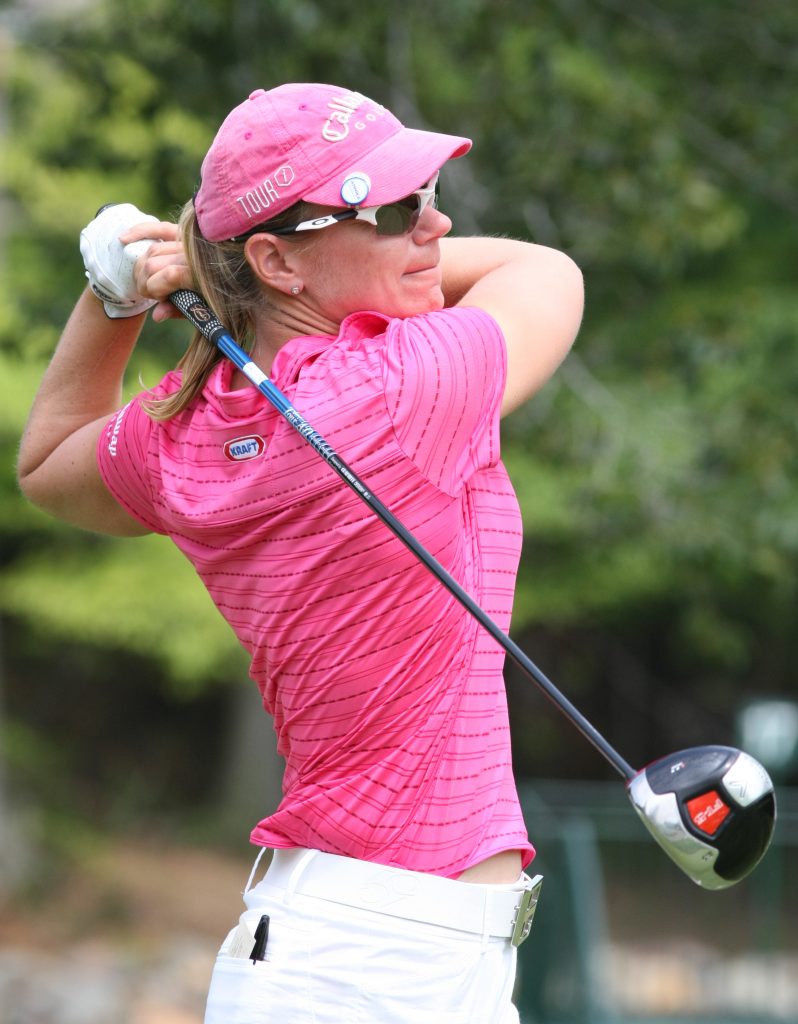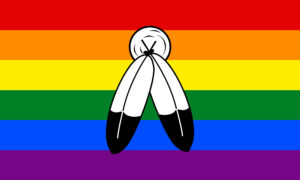In 1950, the formation of the Ladies Professional Golf Association (LPGA) put a spotlight on the largely ignored game of women’s golf. Although improvements have been made throughout the years to boost the women’s game, inequality is still prevalent between men’s and women’s golf. Over the long history of women’s golf, there have been several notable players who have left their mark on the game, such as Michelle Wie, Laura Davis and Mickey Wright. Of all these talented players, one woman who has made significant contributions to end gender inequality in golf is Annika Sörenstam. A Swedish golfer who dominated the LPGA in the 1990s and the early 2000s, Sörenstam established herself in golf history for her significant achievements both on and off the golf course. The event that she is perhaps most well-known for is her participation in the 2003 Colonial National Invitation, where she was the only woman playing against a field of men. This was a historic event that made a statement to the world of golf: women can be just as successful in golf as men. Sorenstam worked hard her entire career to constantly improve herself, and she did that at this tournament while also being an example for women in golf to look up to.
Occurrences of gender inequality in golf did not start with Sörenstam’s historic participation in 2003. The game of golf dates back to the 15th century in Scotland, and exclusion of women is prevalent throughout the history of golf’s development.1 When golf began to grow rapidly in popularity in the 19th and 20th century, women were kept away from participating, and had to play in secret.2 For men, golf was seen as time away from their families and wives to relax and spend time with their friends, not a place for women to join in. When women were eventually allowed to be members of golf clubs, they were subject to strict regulations and were segregated from the men’s section of the golf club.3
Women were and still are widely perceived as being inferior to men at golf, such as the stereotype that women golfers are ‘slower’ than men. As a woman who plays golf at the collegiate level and has played for sixteen years in England, I myself have experienced instances of sexism many times on the golf course. Junior girls represent only 1% of golf club members in England, and I found that my presence on the golf course was often unwelcome by some of the older male players.4 Through my strong ability at golf, I was able to gain more respect from the men at the golf club, yet there were still some men who would not let me play through despite playing faster, due to the stereotype of female golfers being slow players. Beyond the junior level, there is also an issue of gender inequality in golf with relation to business. One of the recent developments of golf is the sociable aspects, and many business meetings are conducted during a game of golf. However, the concept that golf is a ‘men only’ sport has meant that women are rarely invited to participate in these kinds of meetings, even if they are golfers themselves. The situation of gender inequality in golf may have improved slightly since its conception, golf is still very much considered a ‘man’s world,’ and it is into this world that a young Annika Sörenstam rose onto the scene.

Annika Sörenstam was born in Sweden in 1970, into a sport-loving family.5 Her parents were always active and encouraged all her athletic endeavors, and she had a healthy competitive rivalry with her younger sister Charlotta.6 Although they supported their daughters in pursuing different sports, including golf, Sörenstam’s parents did not put pressure on the girls to succeed, instead focusing on keeping sport enjoyable. The family would regularly play golf together, as well as winter sports like skiing, and tennis.7 Despite later becoming a golfing legend, golf was not Sörenstam’s first love. Initially, she enjoyed tennis far more than golf, with dreams of being a successful tennis player. However, she soon discovered that her skills in tennis were not up to the standard needed to be successful. She had too many weaknesses in her game that could not be easily fixed, so she decided to give up tennis as a teenager and began to concentrate on golf.8
Golf is known to all who play it as an incredibly frustrating game, but also incredibly rewarding of hard work. Sörenstam was not a gifted golfer from a young age like Tiger Woods in his youth, but she had the dedication and the determination to achieve her goals. Hard work was not an obstacle to Sörenstam, and her commitment to being the best drove her to success as a young golfer. Many long days and nights were spent at the Bro-Balsta Golf Club as she tirelessly practiced on all areas of her game.9 As a result, Sörenstam performed well in several local and national tournaments in Sweden, even though she struggled with lack of confidence and shyness in front of spectators.10 Eventually, her hard work would earn her a scholarship to the University of Arizona.11 Playing college golf provided Sörenstam with an opportunity to improve her game playing against some of the best golfers in the country. After winning the NCAA championship in her freshman year, being named an All-American and multiple tournament wins, Sörenstam needed to reflect on her ambitions for the future. College golf was no longer proving to be a challenge; she had beaten the best of the best and proven her worth in such a short space of time. At the end of her sophomore year, Sörenstam decided to drop out of college in order to turn professional.12 This proved to be the right move, and Sörenstam’s experience in college catapulted her into success on the Ladies European Tour (LET) and the LPGA Tour.
By 2003, Sörenstam had already had an established career with several LPGA wins under her belt and was generally considered the face of women’s professional golf at the time. She was beginning to feel a similar sentiment to her sophomore year at college. Once most of the LPGA tournaments had been won, what could come next? At this point in her career, she had proven her skill and dominated the women’s game. There was nowhere to go but up; she wanted to push her golf abilities to the next level. This is when the invitation to the 2003 PGA Colonial tournament arrived, and for Sörenstam, it was the perfect challenge. At this point in time, it had been over fifty years since a woman had competed in a men’s event (this previous occurrence was in 1945 when Babe Zaharias qualified for the Los Angeles Open)13. Playing a longer course against players who hit it further than her was going to be difficult, but Sörenstam embraced the difficulty with confidence. Her character naturally thrived in times of challenge; she relished the chance to compare her game to some of the best professionals on the men’s circuit.

Despite the news of Sörenstam’s participation being received in a generally positive way, there was some pushback against it from some of the other professionals competing. There was both acceptance and opposition to Sörenstam participating in the tournament, most notably the world number seven Vijay Singh, who threatened to not play in the tournament if he was in a group with Sörenstam. When asked about the matter, he said: “She doesn’t belong out here. She’s the best woman golfer in the world, and I want to emphasize ‘woman.’ We have our tour for men, and they have their tour. She’s taking the spot from someone in the field.”14 In Singh’s eyes, there should not have been overlap between men’s and women’s golf, and Sorenstam should have stayed on her own tour rather than taking away a spot from a man. The historical status quo of golf had been disrupted, and this hit a nerve for some of the male professionals. From Sörenstam’s perspective, she was incredibly surprised by the intense press coverage. When interviewed about the attention, she said: ”I am overwhelmed. I can’t believe all the attention. It’s funny. Suddenly everyone is an expert on my game and how I think and some of them never saw me play. So it’s just really funny that everybody’s involved in this, but I’m enjoying it as well. I take it as a compliment. And of course, I’d like to play well this week and show them. That’s why I’m here and I’m serious.”15 Despite the fact that she had experienced television cameras and spectators before, this was a different kind of scrutiny. If she buckled under pressure and underperformed, then it would not just reflect badly on her, but on the LPGA and women’s golf in general. She had a lot to gain, but also a lot to potentially lose.
On the first tee, all eyes were on Sörenstam. Being the only female golfer in the tournament put an unimaginable amount of pressure on her shoulders. Although she had experienced high-pressure situations in the past, this was a new level of attention. Whether or not she fully realized it at the time, Sörenstam was not only playing for herself – but she was also representing women’s golf as a whole. Coverage of the event mostly focused on Sörenstam, with commentators especially praising her composure and courage, rather than her athletic skill.16 It was true that she was at a disadvantage in terms of distance compared to her male counterparts, but she did not let that stop her from trying. She was determined to make the cut, referring to being present for the final round: ”I’m very optimistic I’ll be here Sunday.”17 The golfing world was captivated to see how a woman would compare to some of the top professional men.
At the end of two first rounds, Sörenstam was four strokes away from making the cut. Her final score of 145 (71, 74) still put her ahead of nearly a quarter of the men in the field, but not quite enough to secure a spot in the third and fourth rounds.18 While she did not make it all the way in the tournament, she represented herself and women’s golf to the best of her ability and was ultimately proud of what she had achieved. Her performance in this tournament was a learning opportunity, and Sörenstam took what she had learned into the next few years of her career. By the time she retired in 2008, Sörenstam had over seventy LPGA wins under her belt, ten major championships and several other wins on various women’s professional tours. Her legacy has had a significant impact on the world of women’s professional golf. One of the most notable followers of Sörenstam’s PGA appearance was a young Michelle Wie, who competed in several PGA tournaments in the early stages of her career. Sörenstam praised Wie’s participation, continuing to encourage women and girls to challenge themselves and play with the men as she did.19

Annika Sörenstam will certainly be remembered as one of the greatest players in women’s golf. As an inspiration for young girl golfers around the world, Sörenstam proved that hard work could take you infinitely further than talent, and that determination is essential for success in any aspect of life. Her performance in 2003 is one of many highlights in an illustrious career, but the importance of her playing in this event cannot be understated. I can relate very closely to Sörenstam, as I too have often been the only girl or one of a few girls playing in a junior tournament with boys. When I won a junior tournament in 2014 as the only female golfer in the field, my win was met with disdain from some of the male players and their parents, who felt my win was unfair because I played the course from the women’s tees. Junior golf is one of the many areas where there is still a significant gap between men’s and women’s golf, as well as pay differences, television coverage and golf course privileges.20 Nevertheless, it is women like Annika Sörenstam who continue to advocate for women in golf that are working tirelessly to close the gap. More women in golf can follow in her example and be advocates for the women’s game and the skill of female golfers that often is neglected. That is what makes Annika Sörenstam a champion both in the game of golf and in the fight for gender equality in sport.
- Niamh Kitching, Women in Golf: A Critical Reflection in Routledge International Handbook of Golf Science (Routledge, 2017), 1 ↵
- Niamh Kitching, Women in Golf: A Critical Reflection In Routledge International Handbook of Golf Science (Routledge, 2017), 2 ↵
- Niamh Kitching, Women in Golf: A Critical Reflection In Routledge International Handbook of Golf Science (Routledge, 2017), 2 ↵
- Niamh Kitching, Women in Golf: A Critical Reflection In Routledge International Handbook of Golf Science (Routledge, 2017), 2 ↵
- Dax Riner. Annika Sorenstam. Twenty-First Century Books, 2007, 6 ↵
- Dax Riner. Annika Sorenstam. Twenty-First Century Books, 2007, 7 ↵
- Dax Riner. Annika Sorenstam. Twenty-First Century Books, 2007, 7 ↵
- Dax Riner. Annika Sorenstam. Twenty-First Century Books, 2007, 8 ↵
- Dax Riner. Annika Sorenstam. Twenty-First Century Books, 2007, 9 ↵
- Dax Riner. Annika Sorenstam. Twenty-First Century Books, 2007, 13 ↵
- Dax Riner. Annika Sorenstam. Twenty-First Century Books, 2007, 15 ↵
- Dax Riner. Annika Sorenstam. Twenty-First Century Books, 2007, 23 ↵
- Ali Bowes, and Niamh Kitching, 2021. “‘Wow These Girls Can Play’: Sex Integration in Professional Golf.” Qualitative Research in Sport, Exercise and Health 13 (2): 217–34, 7 ↵
- Diane L. Rosenfeld, “Changing Social Norms – Title IX and Legal Activism: Concluding Remarks Comment.” Harvard Journal of Law & Gender 31, no. 2 (2008): 407–22, 409 ↵
- David Poole Anderson. “‘If I Play My Best, I Can Shoot Par.’” The New York Times, May 21, 2003, D2–D2 ↵
- Andrew C. Billings, Caroline C. Craig, Robert Croce, Kristian M. Cross, Kathryn M. Moore, William Vigodsky, and Victoria G. Watson. “‘Just One of the Guys?’: Network Depictions of Annika Sorenstam in the 2003 PGA Colonial Tournament.” Journal of Sport and Social Issues 30, no. 1 (February 1, 2006): 107–14, 113 ↵
- David Poole Anderson. “‘If I Play My Best, I Can Shoot Par.’” The New York Times, May 21, 2003, D2–D2 ↵
- Andrew C. Billings, Caroline C. Craig, Robert Croce, Kristian M. Cross, Kathryn M. Moore, William Vigodsky, and Victoria G. Watson. “‘Just One of the Guys?’: Network Depictions of Annika Sorenstam in the 2003 PGA Colonial Tournament.” Journal of Sport and Social Issues 30, no. 1 (February 1, 2006): 107–14, 113 ↵
- Andrew C. Billings, James Angelini, and Susan Eastman. “Wie Shock: Television Commentary About Playing on the PGA and LPGA Tours.” Howard Journal of Communications 19, no. 1 (January 24, 2008): 64-84, 65 ↵
- Niamh Kitching, Women in Golf: A Critical Reflection in Routledge International Handbook of Golf Science (Routledge, 2017), 8 ↵




22 comments
Michaell Alonzo
Hey Libby, congrats on your nomination for an award for your article. I really liked how you started off by explaining how golf came to be a sport and how it was sexist toward women, yet women still participated in spite of this. I really enjoyed the pictures in your post. I particularly liked the way you presented Annika’s experience and the tenacity with which she pursued her goals. Overall, great article.
Sarah Guerrero
Libby! This is such a great article. You tell Sörenstam’s story well and have a wonderful knack for storytelling. Your nomination is truly well deserved. I have personally been fascinated by the precision involved in golf, so it was nice to be able to read that this was something that Sörenstam had to work for. I think many times we hear stories of professional athletes and their natural ability, not necessarily all the hard work that they have to put in to get them where they are. My favorite part was reading about the impact that Sörenstam had on other female golfers. To me, knowing that you’ve helped others, as Sörenstam did, shows that you’ve really made it. I can’t wait to see how you change the game of golf and what things the game has in store for women. Great job, again!
Nicole Estrada
Congratulations on your award nomination! I think it is truly sad how we are in the 21st century and women are still being compared to men and fighting to be equals as men. I find it mind blowing how men are opposed to women being on a golf course. Compared to men’s sports, women’s sports don’t receive as much attention, thus it was amazing to see some attention was being brought to them by writing this article. Considering how little I know about golf, I was able to understand the article deeply due to being an athlete myself and having a better understanding of the challenges that come from being a woman playing in sports. After reading your article I found it very informative and I can see how passionate you are about this topic. Amazing article! Congratulations!
Jose Luis Gamez, III
I really enjoyed reading your article. Being a golfer myself, I can relate to some of the issues that you brought up about women golfers. Personally, I don’t see a difference between women and men golfers. I sometimes go golfing with my mom and we both really enjoy playing the sport. Everyone should be treated equally. Congratulations on your nomination.
Dallasstar Johnson
Cheers on your publication! You obviously spent a lot of time researching this subject, as I can see! This entire article, as well as the subject it covers, was incredibly interesting to me. Compared to men’s sports, women’s sports don’t generally receive as much public attention, therefore it was awesome to bring some notice to them by writing this article. Considering how little I know about golf, I was happy to learn more. I particularly appreciated the way you included influential golf industry figures.
Dejah Garcia
What a great article I enjoyed reading this article! Congratulations on your nomination ! I loved the imagery you used in your article. It stood out to me and grabbed my attention. I also loved how you structured your article it was very organized and help me to understand and connected with the article. Overall, you did a great job! Again, congratulations!
Kayla Braxton-Young
I really enjoyed how you introduced the story with golf and the main character before moving on to the personal experience and then returning to the protagonist. Because it lends the author credibility and demonstrates why they are enthusiastic about the subject, I have always appreciated it when people include a personal experience within their narrative. This story was excellent since it showed female athletes as more than just what the media portrays them to be. Some women feel shut out by men, because that is how people view them. Women are powerful.
Franchesca Tinacba
Congratulations on your nomination! I truly think this article can help shed some light on female athletes and how they are belittled in the sports industry. Growing up, I remember hearing in high school how girls felt discouraged because many individuals (usually males) looked down on them and their capability to play certain sports. This article proves that anyone can play! No matter the gender, everyone should be able to shine in their own way. Awesome job!
Joshua Marroquin
I would like to start off by saying that this article is well structured and very descriptive, which is impressive to the audience. I am very impressed on how informative this article was, and I would recommend other to read it. It is crazy to understand on how little attention women athletes get compared to men athletes. I would say that this article has a good way on showing the audience how amazing most women athletes are.
Ana Barrientos
Nicely done! I really enjoyed how you first introduced how golf came to be and how golf was discriminatory against women, but women still played despite men being sexist towards them. I really enjoyed how you told Annika’s story and how hard she worked to get there and all the determination she had. Overall, great job and congratulations on your nomination!